Grinling Gibbons (1648 – 1721) is Britain's most celebrated wood carver, his name synonymous with an evergreen style of decoration that transformed the interiors of many of the nation's greatest palaces, churches and institutions. He was also a designer and ran a flourishing business supplying carvings and sculpture in stone, marble and bronze.
Grinling Gibbons as he saw himself

Gibbons' life and career were long, varied and unconventional. Thanks in part to his extraordinary reputation in his own lifetime, we know more about him than most British artists, designers and craftsmen of his day – but the detail is sparse. In his prime, aged 42, Gibbons had himself represented in a portrait, not as a woodcarver at work, but as a successful man of creative intellect and technical ability, an artist rather than a craftsman. Although he came from a prosperous English merchant family living in Rotterdam, the Netherlands, his portrait shows a man far above the relatively lowly station of a carver, the trade in which he is most likely to have been apprenticed as a youth.
Educated in continental artistic traditions and clearly ambitious, Gibbons travelled to England aged 19. He sought not only day-to-day work as a decorative carver in York and later Deptford in south-east London – the centre of British naval shipbuilding – but, unusually, to develop skills as a sculptor and artist that would make him exceptional in Britain in the 1670s. His talents and originality were quickly recognised by knowledgeable and well connected figures, such as the author John Evelyn and artist Peter Lely, leading to royal patronage under Charles II, first at Windsor Castle and later, in 1693, as the King's Master Carver. The portrait by Kneller emphasizes Gibbons' head and hands without needing to allude to the daring and beautiful wood carvings that made his reputation. With its references to mathematical proportion and Gianlorenzo Bernini (the foremost sculptor and architect in Europe), the image evokes Gibbons' intellectual and technical abilities. Gibbons also dealt in paintings and prints from mainland Europe and was celebrated for his 'cabinet' of artworks at home.
What is also very striking about Gibbons' long, London-based career is his success as a businessman. In England he developed opportunities provided by the ostentatious tastes of the nobility when creating palatial properties for themselves, and also by the years of rebuilding London after the Great Fire of 1666. As an independent carver, he quickly developed partnerships and collaborations so as to meet the demands of his expanding clientele. From 1672 (aged 24) he took on journeymen and apprentices whom he could train to his exacting standards. He also bought in the expertise of top class Flemish craftsmen to complement his own.
Gibbons is justly famous for his decorative carvings in limewood but that fame overshadows the fact that he built a versatile business that also supplied statuary and church monuments in stone and marble, and statues cast in bronze. Moreover, he was able to navigate the changing tastes that emerged during the reigns of five monarchs. It is known that Gibbons lived in bustling and creative London neighbourhoods, first at Ludgate Hill near St Pauls, and after 1678 in a large house in Bow Street near fashionable Covent Garden. By maintaining close proximity to his workshop premises, where most production occurred, and also a sizable yard on the south bank of the Thames, Gibbons was managing the largest carving workshop in the country by the 1680s. Rigorous organisation would have been essential to meet exacting deadlines and tight budgets on many of the most expensive building projects of the day. He also had to ensure consistency across huge volumes of highly skilled work, while keeping a wary eye on competitor carvers who had learned to produce excellent work in Gibbons' own style.

Another portrait of Gibbons from about 1690 reveals the more personal and social aspects of his life. Grinling and Elizabeth Gibbons were married in the early 1670s and had 12 children, of whom only five girls survived to adulthood. There is little about the very fashionably presented, and clearly wealthy couple to hint at Gibbons' extraordinary creative talents. The imposing columns and marble relief were conventional features of noble portraiture at the time. Beyond the stability and longevity of their married life, their residency in London's Bow Street and parish connections, there is evidence of Gibbons' enduring friendships and social and business networks within the Drapers' Company which he joined in his twenties, following in his father's footsteps. One further, fascinating glimpse of Gibbons as a creative personality has been uncovered by close analysis of his carvings: a number of uniquely precise details suggest that he had a particular love for, and understanding of, music.
Early life, training, arrival in England and discovery
The content of Gibbons' early training is unclear. He may have worked with ship carvers in Rotterdam and/or worked in the workshop of Artus Quellinus (1609 – 1668), the leading sculptor in the Low Countries whose marble decorations for the Amsterdam Town Hall were highly influential. In any case, this European training helped him develop skills such as drawing and modelling that advantaged him over English trained carvers and sculptors, and would be the foundation of his successful career in Britain.
At the time Gibbons moved to England, artists and craftsmen were in high demand for the work of rebuilding and redecoration in London following the Great Fire of 1666. However, Gibbons first settled in Yorkshire and his earliest surviving work is a small wood panel sculpted in high relief representing King David, based on a painting by Peter Candid (1548 – 1628) which Gibbons would have known via an engraving.
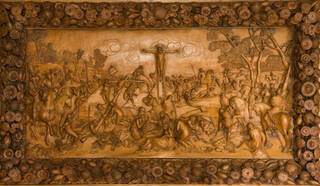
After a few years in Yorkshire, Gibbons moved to the Royal Dockyard town of Deptford, five miles downstream from London. There, he is likely to have been employed in a workshop producing high quality decorative carvings for ships, an important trade at the time. Alongside this professional experience he developed his artistic skills more privately. Shortly before 18 January 1671, Gibbons' career was to take a new path. The famous diarist John Evelyn (1620 – 1706) records how, while walking the streets of Deptford, he looked into a workshop window and discovered the young carver working on a large panel after the Crucifixion of Tintoretto. Gibbons was carving, in wood, Tintoretto's celebrated painting in San Rocco, Venice, once again using an engraving of the original. Evelyn was so impressed by what he saw that he presented Gibbons to King Charles II at Whitehall Palace.
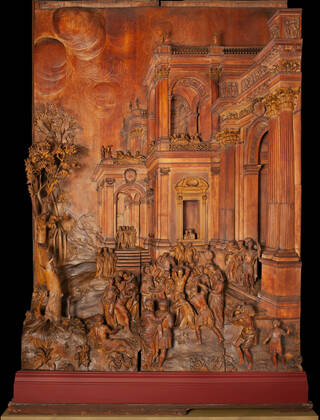
Relating to these two early panels is the Stoning of St Stephen. Made later in his career, the Stoning differs from the early panels by its very large size and highly architectural setting. As no engraved source has been identified, it may be that Gibbons now had the confidence to create an ambitious composition of his own, combining different sources.
Major commissions
Part of Gibbons' business success should be attributed to his development of a highly recognisable style. Though swags of draped fabric and their accompanying drops of flora and fauna can be traced back to the origins of classical ornament, in Gibbons' hands they were transformed into something fantastic and new – a physical volume that had never been seen before. His carvings seemed to leap from the walls, depicting fruit, flowers and game in highly detailed hyperrealism. His work was deeply undercut with sharp edges to give the impression of paper-thin forms, such as petals, with a delicacy that might not withstand the touch of a human hand. His inflated shapes were, in fact, constructed by clever technical tricks, bulked out with rough blocks of wood that gave the illusion of a profusion of objects that had been fully carved in the round.
Gibbons was highly efficient and never wasted time in fully carving all that we appear to see. When his carvings are viewed from scaffolding, rather than from the ground, as he intended, his method becomes clear – as soon as any part of a carving fell out of the sightline of the viewer, no effort was given to its appearance at all. In addition to these techniques, the heightened physicality of Gibbons' work was pushed even further by his clever use of the high-contrast colouring that was so fashionable in the Baroque period. By setting his fresh, pale limewood carvings against dark backgrounds, they were given all the help they needed to stand out visually.
As pioneer of a new style in England, Gibbons attracted powerful patrons and undertook commissions for a great many royal and aristocratic projects. Some of the most splendid country houses and palaces in England displayed his work in wood and in stone, including Holme Lacey, Cassiobury Park, Windsor Castle, Sudbury Hall, Badminton House, Petworth House, Hampton Court Palace and Blenheim Palace. Other schemes have been attributed to him on stylistic grounds but are not documented, such as the carvings at Belton House and Chatsworth.

With such enormous amounts of carved ornament attributed to this one man, it raises the question: was all of it really made by him? Though the idea of such genius is always attractive, in fact, Gibbons ran a large workshop. One description of his time put the number working for him as high as 50. Indeed, production of such a huge volume of carving in so many different buildings would have required the work of many hands. Some of his workers' names are recorded in household accounts. It is known, for example, that at Burghley, his associates Jonathan Maine, Thomas Young and Samuel Watson were all present. The fact that Watson provided the extraordinary carving at Chatsworth tells us that these named people were highly skilled and probably had other unnamed people working under them to rough out blocks or undertake less prominent sections of the work. Having such talented carvers working for him allowed Gibbons to concentrate on designing the work, winning contracts and keeping an eye on the quality and progress of works underway on site.
Watson's drawings of Gibbons' carving at St James Piccadilly, show that Watson made a point of studying Gibbons' work and understood the importance of being able to observe and draw what he saw accurately. He realised that this ability would underpin a style of carving that met Gibbons' standard. This theory is borne out in the sophistication of Watson's carving and the fact that it has frequently been misattributed to the hand of Grinling Gibbons.
Virtuoso carving skills
Gibbons' fame and popularity rest firmly on his virtuoso carving skills which deeply impressed his contemporaries. An assumption that everything he supplied was carved personally is clearly mistaken. It may have been made to his design and under his supervision but no single carver could possibly have produced every part of the large, ensemble carvings that were the mainstay of his business until the 1690s.
His early reputation as an exceptional carver seems to have been based on relief panels with figures, such as the Crucifixion scene witnessed by John Evelyn who admired it for its "curiosity of handling, drawing & studious exactness". Even if we did not have Evelyn's description of events, Gibbons' signature on the panel asserts his claim to have carved them personally. Alongside such highly accomplished, sculptural works in a European tradition, Gibbons clearly understood that virtuosity also depended on surprising the viewer. In the window of his house on Ludgate Hill, Gibbons displayed a carved flower pot of "light wood so thin & fine that the coaches passing by made them shake surprisingly". This was just the kind of thing that people talked about, thereby enhancing his reputation as someone capable of doing the impossible.
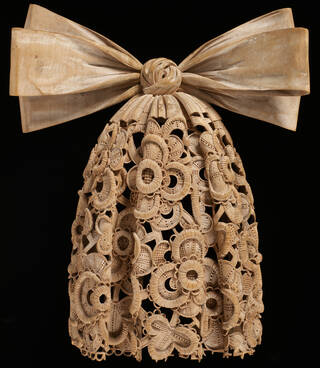
Gibbons' cravat would not have been particularly time consuming to carve, but fulfils other criteria for virtuosity: intricacy, precision and deceptive naturalism. So lifelike is the transformation of solid wood into soft lace that it was mistaken for a real lace cravat when its 18th century owner, Horace Walpole, actually wore it in front of visitors as a joke. It seems likely that Gibbons carved it as a demonstration of his skill to prospective clients – perhaps casually lifting it from a nail on the wall of his workshop as if it were hardly worth speaking about. Beyond its incredible delicacy, it also marks Gibbons out as a creative master of illusionism, able to represent an object more convincingly than the real thing.
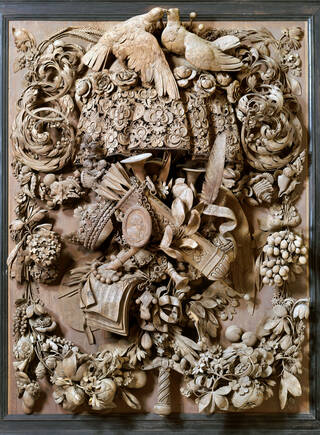
Gibbons' virtuoso skills were at their peak and most publicly demonstrated in the two large panels commissioned as royal gifts in the 1680s for the Grand Duke of Tuscany, Cosimo III de' Medici, and Alfonso IV d'Este, Duke of Modena. On both pieces, Gibbons made a point of carving his own 'signature' conspicuously. The Cosimo panel, in particular (for which Gibbons received £150 – his largest ever payment for a wood carving), is technically brilliant, with subtle surface detail and radical undercutting. The extraordinarily deep design is rich in composition and sophisticated in the symbolism of friendship between princes, interweaving diverse forms and materials in natural and flowing combinations. Gibbons made many hours of painstaking labour and technical brilliance look effortless.
Gibbons as a sculptor in stone and bronze
Gibbons gained his fame as a woodcarver but aimed to be recognized as a stone and bronze sculptor during his lifetime, which was more highly regarded and far more lucrative than woodcarving. Possibly encouraged by Hugh May and Peter Lely, Gibbons developed a parallel career from the early 1680s as a provider of statues, funerary monuments and decorative stonework, associating himself with other sculptors who could help him develop this trade. His great skills as a draughtsman and his ability to oversee a large and organised workshop gave him the capacity to produce a large number of sculptures.
In 1681, Gibbons entered into a partnership with Arnold Quellin (1653 – 86), a marble sculptor trained in Antwerp who had moved to England in 1679. The precise working relationship between the two men is still unclear. The partnership was dissolved two years later, but the two artists reconciled themselves and collaborated on several sculptures in the few years before Quellin's early death in 1686.

In the early 1680s, Gibbons' connections at court also secured commissions to supply several statues in marble and bronze of Charles II and James II. When James II succeeded to the throne in 1685, his ambition to restore Catholicism in Britain led him to commission a magnificent Roman Catholic Chapel at Whitehall Palace from the architect Christopher Wren. Various artists were involved in the speedy construction and decoration of this highly controversial building. Grinling Gibbons and Arnold Quellin, along with 50 workers, produced the stone and marble altarpiece for the chapel, which was inaugurated on Christmas Day, 1686. After the Glorious Revolution in 1688 and the fall of James II, the catholic chapel was closed and then dismantled. Several pieces of the altarpiece now reside at Westminster Abbey and in St Andrew's, Burnham on Sea, Somerset. In the V&A collections, two marble reliefs with putti (cherubs) holding the crowns of Ireland and Scotland, may have formed part of this altarpiece.

During the same years, Gibbons carved a marble baptismal font, the stem of which represents the Tree of Knowledge flanked by Adam and Eve. The font was installed in 1686 in the fashionable church of St James's Piccadilly, where it still stands. An early drawing held in our collections shows the lost original font cover, carved in wood and partly gilded. Although Gibbons was a talented draughtsman, this drawing is not a preparatory study for the font. It was produced in about 1718 by Charles Woodfield and then engraved by George Vertue for his series on ancient buildings, sites, and artefacts called Vetusta Monumenta.
Legacy: 19th century and present day
Taking into consideration such a successful career, it is perhaps unsurprising that Gibbons has a powerful legacy that has thrived though several centuries. He was celebrated in his own time, from the closing years of the 17th century and into the 18th century, for a style of work that was completely new. The fact that it adorned important public buildings, such as St Paul's Cathedral, Trinity College Library, Cambridge, and Hampton Court Palace, ensured that his particular style was not easily forgotten.
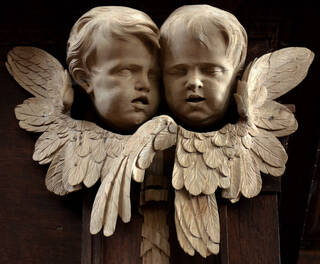
When John Evelyn's Diaries were published for the first time in 1818, his now-famous 'discovery' of the young genius at work in 1671 became widely known, and there was an enormous resurgence of interest in Gibbons' work. Evelyn wrote, "I saw the young man at his carving, by the light of a candle. I saw him to be engaged on a carved representation of Tintoretto's 'Crucifixion', which he had in a frame of his own making". This vision appealed to romantic 19th-century notions of the purity of the hard working but impoverished artist, and a legend was born. Woodcarvers of the period, such as Thomas Wallis, celebrated and emulated his style. They did so in their choice of subject matter, with flora and fauna, but also in the style of their compositions, with drops and swags of entangled natural matter – all of it executed with closely observed details of hyperreal naturalism, seemingly carved in full, in the round.

The legend of Grinling Gibbons gained momentum throughout the early years of the 20th century as great country house interiors were dismantled and sold. The name 'Gibbons' helped make carvings saleable and his works can be found advertised in numerous auction house sale catalogues of the period. It was at this point that Gibbons' work, along with many misattributed examples of Gibbons-style carvings, became part of some of the greatest art collections worldwide.
Today, Gibbons' legacy lives on, assisted, no doubt, by the fact that although much of his work has been moved or altered, some of his most high-status commissions, such as the work at St Paul's Cathedral and Hampton Court Palace, have survived in the public buildings for which they were originally designed and are still there to be enjoyed today. This is also the case for some of his great country house commissions, created in buildings that were originally private, but have since become public spaces.

The sensitivity and beauty of Gibbons' work continues to resonate with contemporary artists. In the work of Arline Fisch, for example, Grinling Gibbons' lace Cravat is the inspiration for a complex and detailed version made in silver wire.

In response to Gibbons, the fleeting nature of our encounters with beauty and nature are captured in the work of Phoebe Cummings, whose works in unfired clay effectively communicate a sense of fragility familiar to anyone who knows Gibbons' work.


